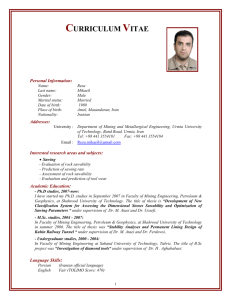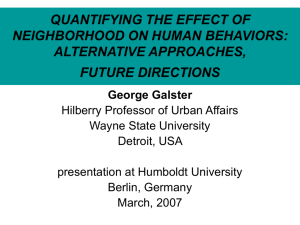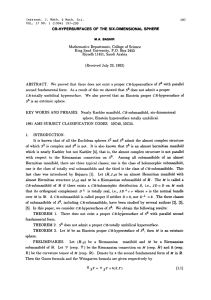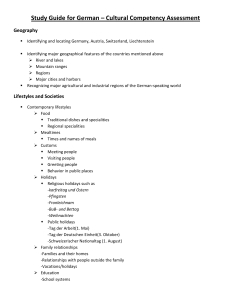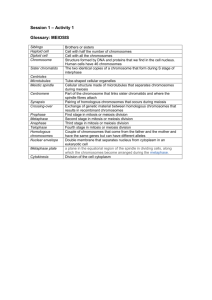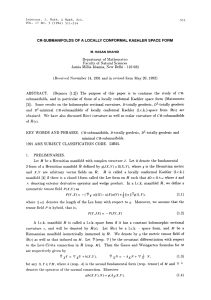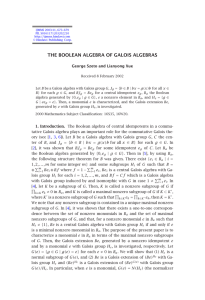FUZZY NEIGHBORHOOD COMMUTATIVE DIVISION 1992)
advertisement
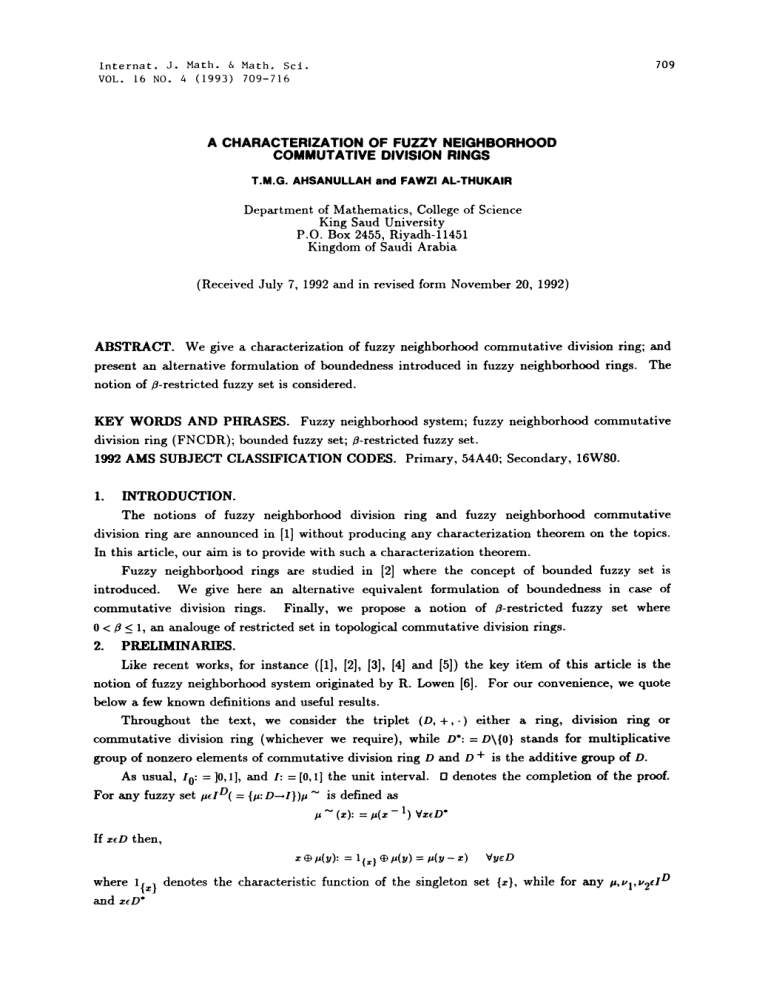
Internat. J. Math. & Math. Sci.
VOL. 16 NO. 4 (1993) 709-716
709
A CHARACTERIZATION OF FUZZY NEIGHBORHOOD
COMMUTATIVE DIVISION RINGS
T.M.G. AHSANULLAH and FAWZI AL-THUKAIR
Department of Mathematics, College of Science
King Saud University
P.O. Box 2455, Riyadh- 11451
Kingdom of Saudi Arabia
(Received July 7, 1992 and in revised form November 20, 1992)
ABSTRACT. We give a characterization of fuzzy neighborhood commutative division ring; and
present an alternative formulation of boundedness introduced in fuzzy neighborhood rings. The
notion of B-restricted fuzzy set is considered.
KEY WORDS AND PHRASES. Fuzzy neighborhood system; fuzzy neighborhood commutative
division ring (FNCDR); bounded fuzzy set; B-restricted fuzzy set.
1992 AMS SUBJECT CLASSIlrICATION CODES. Primary, 54A40; Secondary, 16W80.
1.
INTRODUCTION.
The notions of fuzzy neighborhood division ring and fuzzy neighborhood commutative
division ring are announced in [1] without producing any characterization theorem on the topics.
In this article, our aim is to provide with such a characterization theorem.
luzzy neighborhood rings are studied in [2] where the concept of bounded fuzzy set is
introduced. We give here an alternative equivalent formulation of boundedness in case of
commutative division rings. Finally, we propose a notion of B-restricted fuzzy set where
0 < B < 1, an analouge of restricted set in topological commutative division rings.
2. PRELIMINARIES.
Like recent works, for instance ([1], [2], [3], [4] and [5]) the key item of this article is the
notion of fuzzy neighborhood system originated by R. Lowen [6]. For our convenience, we quote
below a few known definitions and useful results.
Throughout the text, we consider the triplet (D, +, .) either a ring, division ring or
commutative division ring (whichever we require), while D’: D\{0} stands for multiplicative
group of nonzero elements of commutative division ring D and D + is the additive group of D.
As usual, I0: ]0,1], and I: {0,1] the unit interval. Cl denotes the completion of the proof.
For any fuzzy set pID( {p: D.-,l} )p is defined as
,u
():
.u(- I)
If zD then,
where {z denotes the characteristic function of the singleton set {z}, while for any
and zD*
tt,
Vl,V2(lD
T.M.G. AHSANULLAH AND F. AL-THUKAIR
710
x (D #,u q t’2
and
u
D 2 are defined successively,
c. u(u):
v lcbv2(y):
and
u
’(y
{x} u(u)
l)
v Ul(S)Aug(t)
=,+t=u
c u2(u):
,.tv= vUl(S)Au2(t)
for all /D.
Also, we define #/u as
u/u:
pot,
and so 1/(1 3 u) is written as
1/(1
We call
#
(1 u)" ():
t’)(x):
(1
,)(x
l) Va:D*.
is symmetric if and only if
#
#,
where
#(z)
(- z)VztD.
The constant fuzzy set of D with value &l is given by the symbol 6_ (ID).
We recall the so-called saturation operator [6, 7] which is defined on
by
" . ID:&Iot,6F u6{u
a
prefilter base F C I D
< u}.
If E: =(E(z))z D is a fuzzy neighborhd system on a se D hen t(E) is he fuzzy
neighrh tology on D, and he pir (D,t(E)) is known fuzzy neighborhd spce [6].
PROPOSITION 2.1. If (D,t(E)) and (D’,t(E’)) are fuzzy neighrhd spaces and f:D--D’,
< f- l(u’).
then f is continuous at teD O VD’E’(I(r)) and V&loueE(z such that
DEFITION 2.2. Let (D, +,. be a ring d E a fuzzy neighborhd system on D. Then
a fuzzy neighborhd ring if d only if the following are
the quadruple (D, +, .,t(E)) is sMd to
satisfied:
(FR1) The mapping h:(OxD, t(E)x t(E)) (D,t(E)), (t,y) z + y is continuous.
(FR2) The mapping k:(D,t(E)) (D,t(E)), z -z is continuous.
(F) The mapping m:(Ox D, t(E)x t(E)) (D,t(E)), (r,U) zU is continuous.
PROPOSION 2.3. Let (D, +, .,t(E)) be a fuzzy neighborh ring d reD.
Then
(a) The left homothety t:(D,t(E)) (O,t(E)) U zU (resp. right homothety t:(D,t(E))
yz) is continuous. If t is a unit element of D then each homothety is a
--( D, t(E) ), y
u-
hommorphism.
(b) The trslation Tr: (D,t(E))
hommorphisms.
(c) ueE(0)
(d) ueE(z)
(D,t(E)),
U
y+z, d the inversion k e
ueE(z), i.e., Tz(u)eE(x ).
z geE(0), i.e., T z()E(0).
DEFITION 2.4. Let (D, +,. be a division ring, d E a fuzzy neighborhd system on D.
Then the quruple (D, +, .,t(E)) is said to be a fuzzy neighborhd division ring if d only if
the following e true:
x
CHARACTERIZATION OF FUZZY NEIGHBORHOOD DIVISION RING
(FD1) (D, +,-,t(Z;)) is a fuzzy neighborhood ring.
(FD2) The mapping r:(D’,t(EID.))-.(D’,t(EIDO)),
x
x -1
is continuous, where
711
EID. is the
fuzzy neighborhood system on D" induced by D.
THEOREM 2.5. Let (D, +,. be a ring and E a fuzzy neighborhood system on D. Then the
quadruple (D, +, .,t(E)) is a fuzzy neighborhood ring if and only if the following are satisfied:
(1) Vz(D:E(z) (Tz(u):u(E(O)}
(2) Vxo, D, VtE(0), V,tl 0 :lvtE(O)xo(R)v<_+ and v(R)z0_<+, i.e., the mapping v,--XOV
and vvx 0 are continuous at 0.
(3) VinE(0), Wtl 0 :lu(E(0) 3v.u<v+, i.e., the mapping (r,v) r+v is continuous at
(o,o).
is continuous at 0.
(4) Vm}(0), Vl 0 :lutE(0) u <_
+, i.e., the mapping z
tl
the
<
(5) VtttE(0),
mapping (x,v) xv is continuous at (0,0).
0 :lutE(0))u(R)u I +, i.e.,
3. CHARACTERIZATION OF FNCDR AND SOME OTHER RESULTS.
The following is a characterization of fuzzy neighborhood commutative division ring. We
consider X;(0) to be symmetric fuzzy neighborhoods of zero.
THEOREM 3.1. Let (D, +,. be a commutative division ring and (D, +, .,t(X;)) a fuzzy
neighborhood ring. Then the quadruple (D, +, .,t(E)) is a fuzzy neighborhood commutative
,division ring if and only if the following are fulfilled:
(i) VxD:E(x) {Tz(u r)u; utE(O)}.
(ii) VmX;(0), Yx(D, 5(I 0 :lutE(0)9 x(R)v < p +; i.e., VVz is continuous at 0.
(iii) VINE(0), VI 0 :twE(0) ) very < I+, i.e., (x,V)z + II is continuous at (0,0).
(iv) YmE(0), &10 :lutE(0) ) v(R)v < I+= ,i.e., (z,V),--,rV is continuous at (0,0).
-1 (z#0) is
(v) VINE(0), VI 0 :lwE(0))(1.v) <(l*v)+, i.e., the inversion z
continuous at 1.
PROOF. If (D, +,.,t(E)) is a fuzzy neighborhood commutative division ring, then the
conditions (i)- (iv) are immediate from Theorem 2.5. We check condition (v).
Let p E E(0) and I0; then p(r(1)). Since r:x-z-1 is continuous at 1, we can find v E E(0)
such that
uE(1) and r(1 E) u) < (1 q) p) +_.
But r(1 (Bu) _< ( eu)
so ( eu)
< (1 ev)+_Conversely, if the conditions (i) (v) are fulfilled then only we need to prove that the inversion
r:z
is continuous, i.e., we show that
-
Let xeD*,m(0) and
V/te(0), Vz(D, V I 0 lwX(0) 3
_< (x
(z.)
5el 0.
Then in view of (ii), there is a/1(0) such that
< u + /_
q(R)z
Now due to (v), corresponding to Pl
we can find
a
(3.2)
uE(0) such that
(z
Now
(3.1)
UlE(0 such that
(1E)Vl )~ <_ (1 (t) O1) + /_3__
Then by (ii), there exists
(,)
(R)
u) _< u| +
(3.3)
T.M.G. AHSANULLAH AND F. AL-THUKAIR
712
(R)v))" <_ (1 @Vl)"
(1 e(z
+b/3= (from (3.3))
<_ (1 #1)+ 26/3_3_3= (from (3.2))
_< (1 e(z(R)a)) + (26/3)+(6/_3 (from (3.1)).
But then with simplification,
we
have
(zBv)"
which proves
=z
(R)(lB(z
(R)v))
<_(z
[3
B#)+_,
(*).
PROPOSITION 3.2. Let (D, +, .,t(r.)) be a fuzzy neighborhood commutative division ring.
If the conditions (i) (v) of Theorem 3.1 are satisfied then the following inequality hold good.
PROOF. Suppose that the condition (i)
(v) hold good. Let m.(O) and
&l O.
Then there
are #1’ #2(0) such that
and
2 (R) #:Z <- I + 6/3_.
(3.4)
By (v), for every #21(0) Bur(0), u _< 2 such that
(re.)
<_ ( e.)+/_.
(3.5)
Then we have
u/(l (u)
u@(1 u)" (by definition)
.
<uo(1)+/3__ <(01)(u2)+/_3 (by (3.5))
( .) + /
S (z ) + /g
(. ) + z/
Sa+
..
Le (O, +, .)
a commutative division ring uip wih a fuzzy
TM
neighrh o1o (). If (o, + ,()) is a fuzzy neishrhd oup wih resc o addition
:( x D,()x
+ u d (’,-,()) is a fuzzy neighrh oup wih rc
to mtipHcation m:(D*xD*, t()xt())
(D*,t()),(z,y)zy, then (D,+,-,t()) is a zzy
neighrh commutative division ring.
PROF. As the inversion, the dition d subtraction, i.e.,
t())(O,((,,)
r:(D’,t(r.))-,(D’,t(,)),zv-,z- 1,
h:(DxD, t(r.)xt(r.))--. (D,t()), (z,y)
h’:(DxD, t()x t(r.))
(D,t(Z)), (z,!/)
713
CHARACTERIZATION OF FUZZY NEIGHBORHOOD DIVISION RING
are continuous, it is sufficient to show that the multiplication m:(DxD, t(E)xt(E))
(z,p) zy is continuous.
Let E(0) be symmetric fuzzy neighborhoods of zero in the additive group D + of D, and
{z v:.:(0)}
:(z):
~.
We show that
VzD, VyD, Vp(O), V6.I 0 =Ive.E(O) i)
zy.
(vz))(vy)-_
Condition
(**) is satisfied for MI zD’, MD’.
Ind’,
Vz, yeD*,
We let Pzy:
:
0 8’.
^
V .I 0
zE(z) ]yE(y)
zy with pE(0),
P
0z:
Put
Vp=yeE(zy),
z $0E(z)
8p: p$8’E(y) with ,8’E(0).
Then we have
(ve)e(,e)-_ _< (oez))(o’
_<0z (R) Oy-=6 _< Pzy
p
zp,
z
y
as desired.
It remains to show that if zy 0, then (**) is satisfied. First, let
I0; then by Proposition 2.3(c), $ pE(1).
0; suppose pE(0) and
There exists OE(0) such that
eee<p+/.
Consequently,
as
multiplication rn:(z,p)zp is continuous at (1,1), there exists
v Ov
Then in ew of Prosition
UlE(0 ). Let us put
2.3(d),
u:
th u(0) d hen,
which proves that
<_ (1 e)+ /.
-lu dv: =vA8
(3.6)
leE(1) such that
(3.7)
_
T.M.G. AHSANULLAH AND F. AL-THUKA[R
714
,n:(t,y)ry is continuous at (I,t), then
Next, let t # 0 v. Since the multiplication
that
VIrtUE(x), V&I 0
:]
vIE(I qv:E(x) v
vz:
v !.
Set
v:
#
^ #’.
p
*,
’v
(***) implies
lz"
with p(0);
z0’ with 0,0’E(0).
1,0, %.:
Then it follows immediately that
v) <
(1 ,v) (D (z
(by (3.8))
and consequently, (t,z)c _< a +_6 which proves that
vr.(0), w’, v6 0 3.(0)(). <_
.+.
u
DITION 3.4. Le (D, +,.) e a commutative division ring and (, +,.,()) a fuzzy
neighrh ring. Then a fuzzy set ml D is said to be uuded iu (D, +, .,t()) if and only if for
1 mE(0) d for 1 &l 0 there exists &Z(0) such that 0
a commutative division ring d (D, +,..(E)) a fuzzy
PROPOSITION 3.5. t (O, +,.
neighrh ring. Then the following statements are equivMent"
(B1)" mi D is unded in (D, +, .,());
(B2). w,(0), w, 0 o’+.
PROF. (B1)o(B2) is triviM, we prove (B2)(B1). Let I D, w(O) and &l 0. Then in
view of Threm 3.1 (iv) there exists a v’Y(o) such that
,- / <
(3.)
v+.
,
By by, thesis, there is xCD" such that
v-*/3 <v’
(3.10)
Thus we have
v’(v)
S
v’v’+*/
<
v+26/3_
((a.o))
(3.11)
((3.o))
Again applying Theorem 3.1(ii), we can find OeX;(0) such that
+6/_3
< v’
So for any zeD:
= + 6/_3
(3.12)
v (,) A a()
O(z)
/=z
<
v ,(s) A (,/ =)() + /3
/=(R) (v’
u(z) + 26/3 + 6/3
(,u(3. ]))
(z) + 6
715
CHARACTERIZATION OF FUZZY NEIGHBORHOOD DIVISION RING
DEFINITION 3.6. Let (D, +,.) be a commutative division ring and (D, +,.,t(E)) a fuzzy
neighborhood ring. A fuzzy set ml D is said to be 3-restricted in (D, +,., t(:)) for 0 < 3 _< if and
only if
,~(0) < 3,
is the fuzzy closure operator given in Proposition 2.3 [6]
PROPOSITION 3.7. Let (D, +,. be a division ring and (D, +, .,t(E:))
ring. Then the following statements are equivalent:
(R1)" #eI D is 3-restricted in (D, +, .,t(E)) for 0 < 3 _< 1;
Where
a
fuzzy neighborhood
(R2)" 3v,;(0) (R)v(1) < 3.
PROOF. -(R1)=(R2). Let 0 < 3 _< 1, and mi D be 3-restricted. Suppose that uE(0)
that #(R)v(1) _> 3; i.e., v zy l#(Z) A v(y) _> 3
=>3zD,yD* such that zy 1, i.e., z y-1 such that
is such
(v- 1)^ v(y) > 3
A
ve(O)
A
wr.(o)
V
v #~()Av(V)>3
D"
--(0) >_ 3,
contradiction with the fact that
restricted for 0 < 3 _< 1.
This means simply that
A
v-(O)
V
ID*
is
,
3-restricted. (R2)=:,(R1). Let
pl D be not 3-
(v) v() _> 3
^
=v,,(o): v
() ^,,(u) > 3.
teD*
Now we have
#@
u(1)=aV=
v
a contradiction with
1.
2.
3.
4.
leD*
,
(t) v(t) >_ 3
^
(R2).
AHSANULLAH, T.M.G., Fuzzy neighborhood modules and algebra, Fuzzy Sets and
Systems 35, (1990), 219-229.
AHSANULLAH, T.M.G. & GANGULY, S., Fuzzy neighborhood rings, Fuzzy Sets and
Systems 34, (1990), 255-262.
AHSANULLAH, T.M.G. & MORSI, N.N., Invariant probabilistic metrizability of fuzzy
neighborhood groups, Fuzzy Sets and Systems 47, (1992), 233-245.
KATSARAS, A.K., Linear fuzzy neighborhood spaces, Fuzzy Sets and Systems 16, (1985),
25-40.
MORSI, N.N., Nearness concepts in fuzzy neighborhood spaces and in their fuzzy proximity
spaces, Fuzzy Sets and Systems 31, (1989), 83-109.
716
6.
7.
8.
9.
T.H.G. AHSANULLAH AND F. AL-THUKAIR
LOWEN, R., Fuzzy neighborhood spaces, FZY Sets and System.v 7, (1982), 165-189.
LOWEN, E., LOWEN, R. & WUYTS, P., The categorical topology approach to fuzzy
topology and fuzzy convergence, Fuzzy Sets and Systems 40, (1991), 347-373.
KAPLANSKY, I., Topological rings, Amer. J. Math. 69, (1947), 153-182.
WANG-JIN, L., Operations on fuzzy ideals, Fuzzy Sets and Systems 11, (1983), 31-41.
